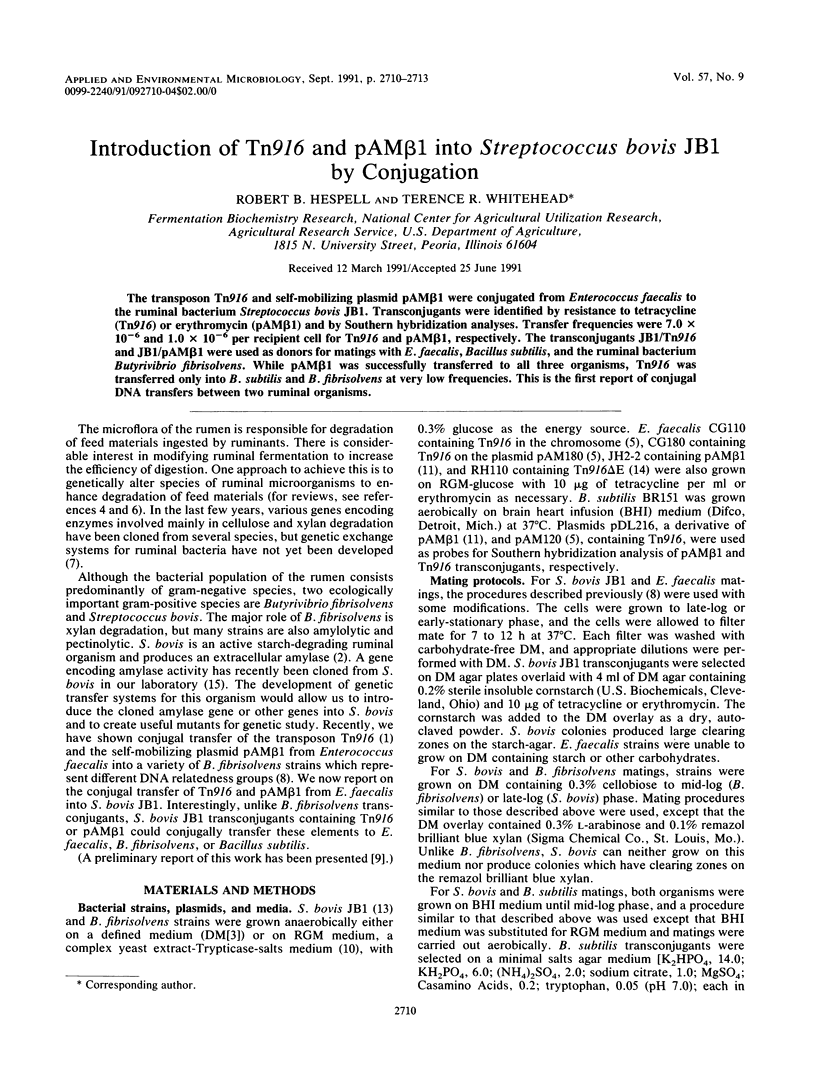Abstract
The transposon Tn916 and self-mobilizing plasmid pAM beta 1 were conjugated from Enterococcus faecalis to the ruminal bacterium Streptococcus bovis JB1. Transconjugants were identified by resistance to tetracycline (Tn916) or erythromycin (pAM beta 1) and by Southern hybridization analyses. Transfer frequencies were 7.0 x 10(-6) and 1.0 x 10(-6) per recipient cell for Tn916 and pAM beta 1, respectively. The transconjugants JB1/Tn916 and JB1/pAM beta 1 were used as donors for matings with E. faecalis, Bacillus subtilis, and the ruminal bacterium Butyrivibrio fibrisolvens. While pAM beta 1 was successfully transferred to all three organisms, Tn916 was transferred only into B. subtilis and B. fibrisolvens at very low frequencies. This is the first report of conjugal DNA transfers between two ruminal organisms.
Full text
PDF



Images in this article
Selected References
These references are in PubMed. This may not be the complete list of references from this article.
- Clewell D. B., Gawron-Burke C. Conjugative transposons and the dissemination of antibiotic resistance in streptococci. Annu Rev Microbiol. 1986;40:635–659. doi: 10.1146/annurev.mi.40.100186.003223. [DOI] [PubMed] [Google Scholar]
- Cotta M. A. Amylolytic activity of selected species of ruminal bacteria. Appl Environ Microbiol. 1988 Mar;54(3):772–776. doi: 10.1128/aem.54.3.772-776.1988. [DOI] [PMC free article] [PubMed] [Google Scholar]
- Cotta M. A., Hespell R. B. Proteolytic activity of the ruminal bacterium Butyrivibrio fibrisolvens. Appl Environ Microbiol. 1986 Jul;52(1):51–58. doi: 10.1128/aem.52.1.51-58.1986. [DOI] [PMC free article] [PubMed] [Google Scholar]
- Forsberg C. W., Crosby B., Thomas D. Y. Potential for manipulation of the rumen fermentation through the use of recombinant DNA techniques. J Anim Sci. 1986 Jul;63(1):310–325. doi: 10.2527/jas1986.631310x. [DOI] [PubMed] [Google Scholar]
- Franke A. E., Clewell D. B. Evidence for a chromosome-borne resistance transposon (Tn916) in Streptococcus faecalis that is capable of "conjugal" transfer in the absence of a conjugative plasmid. J Bacteriol. 1981 Jan;145(1):494–502. doi: 10.1128/jb.145.1.494-502.1981. [DOI] [PMC free article] [PubMed] [Google Scholar]
- Hespell R. B. Biotechnology and modifications of the rumen microbial ecosystem. Proc Nutr Soc. 1987 Sep;46(3):407–413. doi: 10.1079/pns19870055. [DOI] [PubMed] [Google Scholar]
- Hespell R. B., Whitehead T. R. Conjugal transfer of Tn916, Tn916 delta E, and pAM beta 1 from Enterococcus faecalis to Butyrivibrio fibrisolvens strains. Appl Environ Microbiol. 1991 Sep;57(9):2703–2709. doi: 10.1128/aem.57.9.2703-2709.1991. [DOI] [PMC free article] [PubMed] [Google Scholar]
- Hespell R. B., Wolf R., Bothast R. J. Fermentation of xylans by Butyrivibrio fibrisolvens and other ruminal bacteria. Appl Environ Microbiol. 1987 Dec;53(12):2849–2853. doi: 10.1128/aem.53.12.2849-2853.1987. [DOI] [PMC free article] [PubMed] [Google Scholar]
- Leblanc D. J., Lee L. N. Physical and genetic analyses of streptococcal plasmid pAM beta 1 and cloning of its replication region. J Bacteriol. 1984 Feb;157(2):445–453. doi: 10.1128/jb.157.2.445-453.1984. [DOI] [PMC free article] [PubMed] [Google Scholar]
- Rubens C. E., Heggen L. M. Tn916 delta E: a Tn916 transposon derivative expressing erythromycin resistance. Plasmid. 1988 Sep;20(2):137–142. doi: 10.1016/0147-619x(88)90016-9. [DOI] [PubMed] [Google Scholar]
- Russell J. B., Baldwin R. L. Substrate preferences in rumen bacteria: evidence of catabolite regulatory mechanisms. Appl Environ Microbiol. 1978 Aug;36(2):319–329. doi: 10.1128/aem.36.2.319-329.1978. [DOI] [PMC free article] [PubMed] [Google Scholar]




